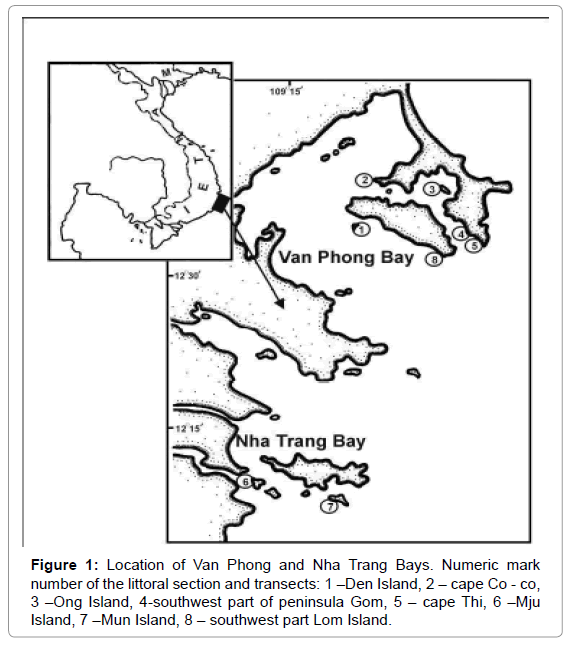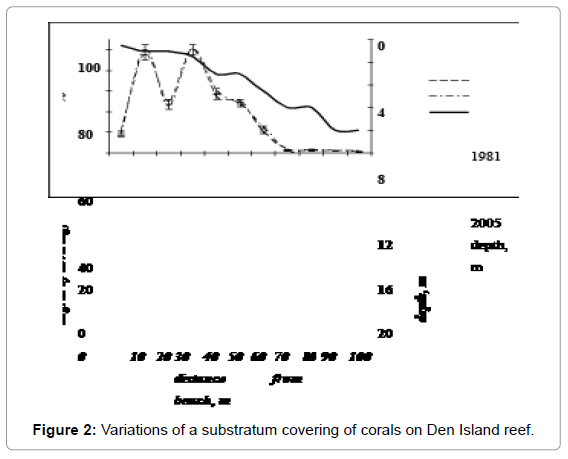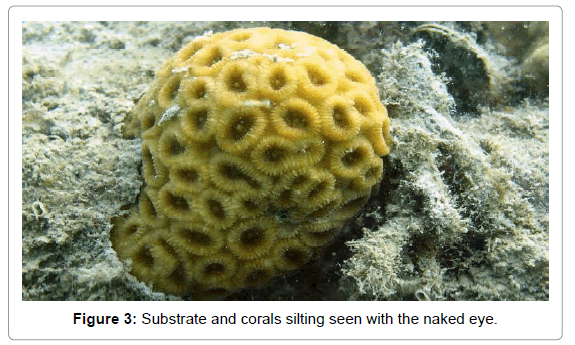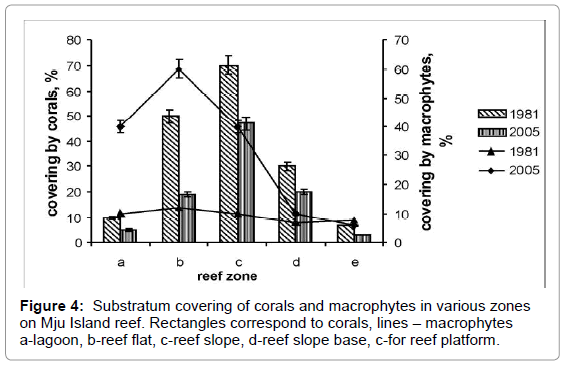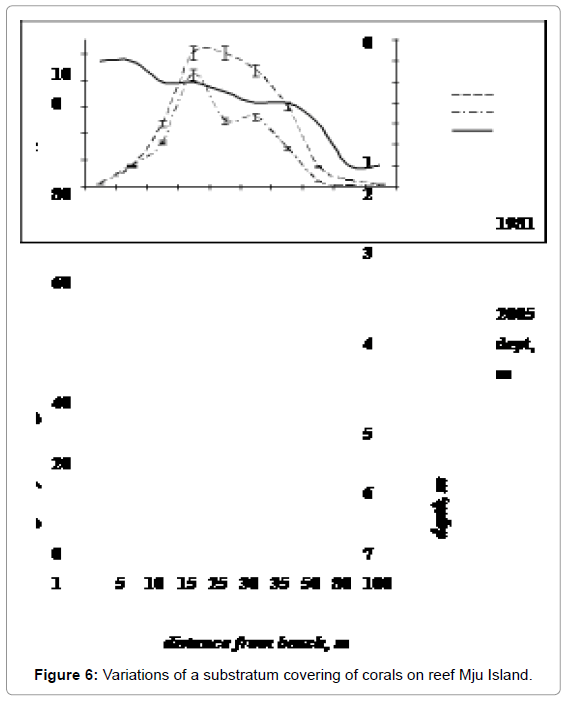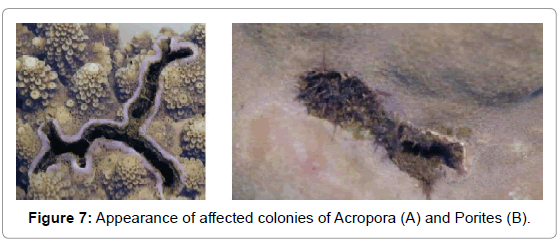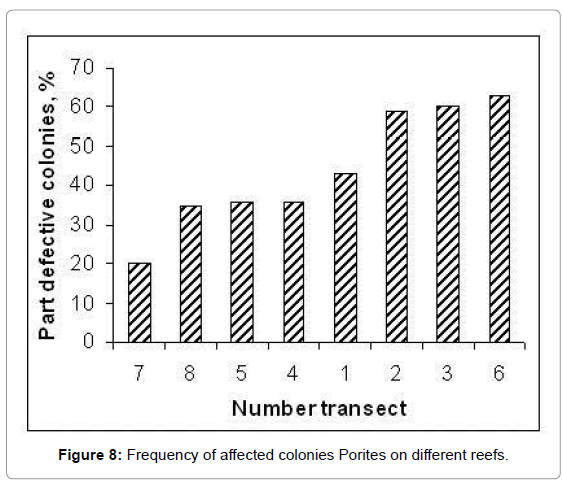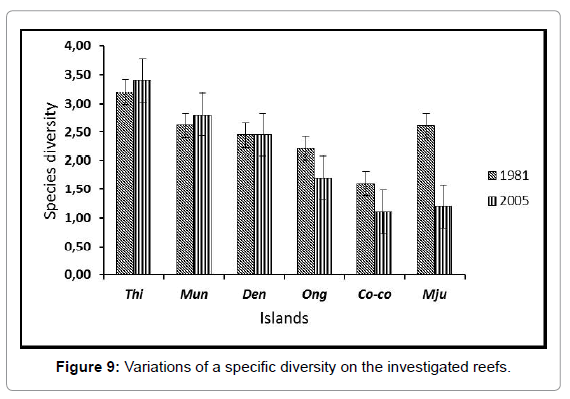Research Article Open Access
Some Data on the Composition and Structure of Coral Communities in the Littoral and Sublittoral in the Province of Khanh Hoa, Vietnam
Yuri Ya Latypov*A.V. Zhirmunsky Institute of Marine Biology, Far East Branch Russian Academy of Sciences, Russia
- *Corresponding Author:
- Yuri Ya. Latypov
A.V. Zhirmunsky Institute of Marine Biology
Far East Branch Russian Academy of Sciences, Russia
E-mail: ltpv@mail.ru
Received date: December 05, 2013; Accepted date: December 26, 2013; Published date: December 31, 2013
Citation: Latypov YY (2013) Some Data on the Composition and Structure of Coral Communities in the Littoral and Sublittoral in the Province of Khanh Hoa, Vietnam. J Marine Sci Res Dev 4:141. doi:10.4172/2155-9910.1000141
Copyright: © 2013 Latypov YY. This is an open-access article distributed under the terms of the Creative Commons Attribution License, which permits unrestricted use, distribution, and reproduction in any medium, provided the original author and source are credited.
Visit for more related articles at Journal of Marine Science: Research & Development
Abstract
A composition and structure of coral communities of littoral and sub littoral two large bays Van Phong and Nha Trang of Khang Hoa province in South Vietnam were studied. Intertidal zonation of communities identified. Clear pathological changes of corals due to anthropogenic impact. Set optimal status of coral communities protected reefs and dramatic changes on reefs subject to anthropogenic influences. Five types of intertidal zone investigated. It has been established that rocky-stony littoral possesses the greatest biodiversity (5 belts have been distinguished in vertical communities). A lagoon type littoral studied for the first time.
Keywords
Littoral; Sub littoral; Species composition; Structure; Coral community; Vietnam
Introduction
The first studies of the southeastern coast of Vietnam were conducted by Loi [1] and were restricted to Nha Trang Bay. In the 80s of the previous century, according to the agreement on the scientific collaboration between the Institute of Marine Biology FEB RAS (Vladivostok) and the Institute of Oceanography of the Vietnamese Academy of Sciences and Technologies (Nha Trang), a systematic investigation of tidal zone of the south and southeastern coasts of Vietnam was carried out. The area of investigation covered heavily indented southeastern part of the Vietnamese coast (Phan Rang and Phu Khan Provinces), beginning from the Din Cape (11º22´N; 109º1´E) up to the Ro Bay (12º52´N; 109º27´E), and included a number of gulfs and bays of various sizes and shapes (the greatest of them are Ben Goy, Van Phong, Nha Trang, Phan Rang), many islands, islets and single rocks. Besides, Nam Zu Islands (Gulf of Thailand) and Thu Island (South China Sea) were also investigated. The results of these investigations were published in a number of articles, books and monographs [2-6].
Coral reefs of Vietnam are an integral part of Indo-West Pacific Tropical Center of coral origin and diversity [7-13]. They represent a surprisingly productive natural ecosystem with a diversity of ecological niches and numeral inhabitants. At the same time, coral reefs serve as a basis for many branches of economic activity (fishery, construction, tourism, etc.). They serve as a natural barrier against destructive wave action, protecting a coastline from erosion. Coral reef is actually a living barrier, which dying basis is constantly replaced in the result of coral growth [14]. Besides, coral reefs, through their own erosion, serve as the main source of sand, replenishing critically destructed coasts. It is especially important for many provinces of Vietnam with sandy coasts.
In the recent decades cases of negative impact on coral reef ecosystem as an object of intensive nature management are registered more often [14-16], and as a result of that the number of various coral diseases is growing [17]. The aim of this work is to study changes, taking place in Vietnamese coral reefs under the conditions of natural processes and anthropogenic impact.
In 2005 joint Russian-Vietnamese investigations of the southeastern Vietnam, including Van Phong and Nha Trang Bays (Phu Khan Province), were resumed.
A short physic-geographical outline
The studied area exposed to the effect of atmospheric circulation, which is formed over the southeastern Asia and determines here a monsoon climate, characterized by interchange of dry (January-August) and rainy (September-December) seasons, and by winds of stable directions: in summer – southwestern, and in winter – northeastern [18]. Due to irregularity of the coastline, the most part of the studied coast is exposed to the 1-3 degree surfs, and only on the open coast areas (southeastern coast of Lon Island), it can reach the 3-4, and even the 5th degree.
Water temperature near the southeastern coasts of Vietnam closely connected with monsoon climate, and its mean value in Nha Trang outskirts varies from 23.8ºC in January up to 28.2ºC in May-June. Absolute minimum is 14.6ºC. Water temperature in Nha Trang Bay varies on the average within the range from 23.5ºC in January to 29.5ºC in May, and very seldom drops lower than 21ºC and rises higher than 33ºC. Salinity of coastal waters is close to the ocean normal one, and only in top parts of bays and in closed bays it can drop for short periods during tropical downpours. Along the southeastern coasts of Vietnam drift currents, going parallel to the coastline, are observed, which are formed under the effect of southwestern and northeastern monsoons. Tidal currents are weak and got over by drift currents.
Tides in Van Phong and Nha Trang Bays are irregular circadian. Near the port of Nha Trang average sea level is 1.35 m, tide is about 2.5 m, average level of high tropical tide is 2.0 m, and that of low tropical tide is 0.7 m. Level of high and low equatorial tide is 1.6 and 1.1 m, respectively. Since it is exactly the level that determines boundaries of levels and floors (stories?) on intertidal zone with daily tides [19,20], then the scheme of vertical division of intertidal zone into levels and levels near southeastern Vietnam looks in Table 1.
| Height above 0 depth in cm | Level | Level |
|---|---|---|
| 201-250 | upper | |
| 161-200 | lower | I, or upper |
| 136-160 | upper | |
| 111-135 | lower | II, or middle |
| 71-110 | upper | |
| 0-70 | lower | III, or lower |
Table 1: Vertical division of intertidal zone of the South Vietnam.
Thus, in the studied area due to the strong difference in the amplitude of tropical and equatorial tides average level of intertidal zone has a very small vertical length (totally 1/5 of the entire intertidal zone). The lower floor (story) of the lower level (28% of the entire intertidal zone) is especially great, and it submerged most of the time. According to calculations of Loi [1] during 1964 even the level of 0.7 m, corresponding to the upper limit of this floor (story), was exposed for less than 4% of the total year duration. The level of 1.1 m, corresponding to the boundary of the middle and lower levels, was exposed for 86.1%, and the level of 2 m, corresponding to the boundary between floors of the upper level, was exposed for 98.1% of the total time.
Materials and Methods
Littoral area
Works on investigation of qualitative composition of macrobenthos conducted using the method of chorological study, which is widely used by many hydro biologists in various modifications [21]. A hydrobiological section athwart to the coastline made on a site, the most typical for a certain binomial type (Figure 1). Belt-forming groups (if any) preliminarily distinguished on the section, the width of every belt was measured and from every belt several samples were taken, which were typical for a group population composition. Totally 8 hydrobiological sections were made. Due to the small number of the intertidal group and the absence of experts-taxonomists, quantitative samples usually not taken on sections, and only binomial and faunistic investigations carried out. From 3 to 6 stations in different stories and levels of the intertidal zone and intertidal basins were made at every section, depending on binomial diversity. Totally 33 stations were examined. In addition to qualitative macrobenthos sampling, quantitative calculation of mass animal’s species carried out at one of the sections in Van Phong Bay. At these section 14 record frames with the area of 0.05 m2 in the upper level of intertidal zone in litorinidae community, and 20 frames with the area of 0.1 m2 in the middle level in ostracean community were taken. Within the period of works, tides were irregular, daily. The height of rising tide reached 2.4 m, and low tide was from 0.2 m above 0 depth or higher. Low tides occurred in morning hours (from 4 a.m. on January 9 to 8 a.m. on January 18 for the 8th time zone). The works conducted from 8.30 a.m. to 11 a.m.
The samples were delivered aboard the vessel, where they were sorted by taxonomic groups and species, and fixed in 80% alcohol or 4% formalin. A part of the collected samples handed to the Vietnamese colleagues according to their wish. The most part of the materials delivered to the museum of the Institute of Marine Biology of the Far- Eastern Branch of the Russian Academy of Sciences. Mollusks were identified, if possible, to species in the laboratory aboard the vessel.
Sub-littoral area
Species composition and structure coral community and accompanying fauna was carried out according to the standard SCUBA methods along a transect with 1 m marking, established athwart to the coastline from the water line up to the base of a reef-slope [22,23]. Transects were established perpendicular to the shoreline and lay along the bottom of the profile to a depth of 11-18 meters (Figure 1). The profile of each transect was established and the boundaries of the zones were marked. The living coral cover was recorded with the number of dominant taxa (genera and species). Abundance of common species of mollusks and echinoderms, branched, massive, encrusted and funnel -shaped scleractinian colonies, as well as the degree of substratum cover by corals were estimated along a 100 m transect frame 1m2 divided into 100 squares with the area of 10 cm2 each. Photographing every square meter with frame 1 m2 along the whole transect as well as of reef landscapes and their flora and fauna was conducted. More than 250 photos by Olympus digital cameras were made for later analysis of species composition [24-26]. Coefficients of species diversity corals were calculated by the formula: H = -Σ [(ni/N)×(ln ni / N)], where H – Shannon Diversity Index, n- number of individuals belonging to i species, N– total number of individuals. Table 2 For the purpose of comparison the results of earlier investigations, conducted at the same reefs in 1981 and 1982, were used, as well as data on sedimentation intensity, obtained in 2005 with the help of sedimentation traps [27]. Indices of species diversity (D) were calculated by the formula: D = (S-1)/lgn N, where S is a number of species, and N is a number of individuals.
| 3.0 m | Supralittoral | Littorinidae belt Littorinidae belt + Balanidae |
| 2.5 m | Upper level Upper level of littoral Lower level |
|
| 2.0 m | ||
| 1.6 m | Upper level Middle level of littoral Lower level |
Saccostrea cucullata belt |
| 1.35 m | Saccostrea cucullata belt + Malvufundus regularis Algal mosaic belt (Sargassum, Padina, Turbinaria, calcareous incrusted and branched, etc.) |
|
| 1.1 m | Upper level Lower level of littoral Lower level |
Coral polyp belt (Scleractinia, Alcyonaria, Millepora) |
| 0.7 m 0 m |
Table 2: A combined pattern of vertical distribution of communities on rocky littoral of Nha Trang and Van Phong Bays.
Results and Discussion
Littoral community
Rocky-boulder littoral, which is the most diverse in communities, studied the most thoroughly. A combined pattern of vertical distribution of main communities on rocky littoral given in Table 1, a community of gastropod mollusks of Littorinidae family occupies the lower part of supralittoral zone and the uppermost part of intertidal zone. At Section 8, where stock-taking of animals was conducted, the general population density in the community was equal to 44.2 sp./m2, and biomass – 30.94 g/m2. Gastropod mollusks Tectarius granulatus (16.5 g/m2 23.6 sp./m2), Nodilittorina feejeensis (13.0 g/m2; 18.6 sp./m2), and Pisiella sp. (1.1 g/ m2; 1.6 sp./m2) prevail in the community. Besides, gastropod mollusks Morula musiva and Nerita undata, bivalves Isognomon sp. and barnacles Tetraclita sp. were also registered in the community, but their biomass did not exceed 1 g/m2, and population density – 1sp./m2. Diogenescrabs, goose barnacles, gastropods settle on flat rocks in littoral basins. In the upper level of the middle level barnacles of Chthamalus genus join this community, but their biomass did not exceed 1 g/m2, and population density – 1 sp./m2
The lower part of the middle level and the upper level of the lower level, as a rule, are occupied by a community of Saccostrea cucullata oyster. Oysters biomass at Section 8 was equal to 290.1 g/ m2, and population density – 17.8 sp./m2 The width of oysters belt varies from 30-40 to 60-75 cm, but except for living oysters, dead animals can be also frequently met. Their density at Section 8 was 5.4 sp./m2. One more bivalve Malvufundus regulus joins the oyster’s belt in the upper level of the lower level of other animals, Gastropoda and Stomatopoda are the most abundant here. Polychetes can be met not so often. In some places, a light belt of Tetraclita acorn barnacle can be viewed between Chthamalus and oysters.
Composition of littoral population varies very much in the lower level of the lower level below oysters. A community with coral polyp dominance generally develops in the lower part of rocky littoral of Van Phong Bay. More often they are reef-building Scleractinians, forming massive dense populations, turning to sublittoral zone, as well as Alcyonarinas and Millepora. A belt of algal mosaic with the dominance of Sargassum, Padina and calcareous green and red (both incrusted and branched) algae passes between oysters and corals in Nha Trang Bay. Of accompanying fauna Gastropoda and Stomatopoda prevail, and echinoderms and hydroids can be met fairly often. On the entire littoral and supralittoral big Grapsus crabs and very movable swellfish of Salarias genus is common. Main communities on stony littoral are the same as on rocky one, but they differ by spot pattern of distribution and quantitative coefficients. Besides, the most part of the lower littoral level consists mainly of sand with separate stones, and coral belt is absent here (only small colonies can be met on some stones), and algal belt, if available, is developed.
In contrast to rocky-clumpy littoral, infauna is represented here rather abundantly: numerous gastropod mollusks Nerita albicillata, N. costata, N. polita, N. undata, Morula musiva, M. aspera, Thais sp., Chicoreus brumeus, Cypraea arabica and others find their shelter under stones in pools, as well as numerous Stomatopoda and some Polychaeta. Big holothurians can be frequently met on sand among stones.
Species composition of sandy littoral is very poor. Intertidal zone of this type, studied by us (Section 4), is formed of course or, more seldom, medium sand with a touch of grinded coral and shell debris. Of macrobenthos, we found here only crabs of Clibonarium genus, which actively run about the entire littoral. Diggings of these crabs are situated on the boundary between intertidal and supra littoral zones.
Lagoon littoral type was examined by us only once (Section 5). The lagoon is located at the distance of 15 m from intertidal zone behind a sand bar, connected with the sea by a narrow canal (during low tide water leaves the lagoon); a small stream flows into it at the opposite side. From one side the lagoon edged with lumps, and from another side – with sand. The lagoon depth is up to 1 m. The bottom covered by silted sand. During our work, (low tide period) water salinity of the lagoon was equal to 27.4%, pH – 7.15. However, already on the next morning in low tide period (after night high tide of 2.4 m) water surface salinity in the lagoon was equal to 28.5‰, temperature – 24.4°C, and that of the bottom – 32.2% and 24.7°C.
Mangroves grow in the central part of the lagoon on a sandbank. Only Littorinidae gastropod mollusks and very rare oysters (mainly dead) found on lumps above the water line, and below the water line in lump cracks – very rare sea urchins of Diadema genus. There were crab diggings on sand above the water line. Lagoon bottom is outwardly lifeless. Swellfish of Salarias genus swim in the water depth.
Spatio-temporal stability and variability of coral reefs
Biological state of corals was evaluated by the presence/absence of functional and morphological symptoms of pathology (bleaching, disruption of coral colony integrity in a form of strips and cracks of various color), which were the result of negative impact of bacteria, protista, other organisms and abnormal effects of abiotic environmental factors. The presence of such big corallobionts, as bivalves and Polychaeta, in a colony was not taken into account. On every reef slope at 2-6 m depth 30-40 coral colonies of Porites genus (P. australiensis, P. cylindrical, P. lobata, P. nigrescens, P. rus) with the diameter more than 10 cm randomly examined, at that coral portion with traces of pathology was estimated. On a reef near Mun Island in Nha Trang Bay and on a reef near Lon Island in Van Phong Bay coral colonies of other mass species on 2 m2 area were examined in the same way.
Description of the reefs
The studied reefs differ by their geomorphology, the degree of wave action and connection with the open sea, according to which they classified as reefs of open capes and islands, and reefs of inner bays and straits [23,28,29]. Near the open coasts of Den, Lon, Mun Islands and the southwestern end of Gom Peninsula (transects 1, 8, 7, 4 and 5) in active hydrodynamic conditions coral colonies of comparatively small length (up to 25-100 m from the coast), confined to steep or vertical rocky and stony walls, are usually common. The reefs are characterized by the high species diversity of Scleractinian (not less than 200 species) and the same high degree of substrate covering (60-100%), as well as the presence of great number of young corals, which settled relatively not long ago (Figure 2). Species, met on the most Indo-Pacific reefs, are the most frequent in the community:
Pocillopora verrucosa. Acropora cytherea, A. florida, A. millepora, A. gemmifera, Montipora hispida, M. vietnamensis, Porites lobata, P. cylindrical, Favia maritima, Favites flexuosa, Platygyra daedalea, Leptoria phrygia, Diploastrea heliopora, Goniastrea pectinata, Hydnophora microconos, Lobophylla hemprichii, Symphyllia recta, S. radians, Galaxea fascicularis, Fungia fungites, Sandalolitha robusta, Podabacia crustacea, Merulina ampliata, Pectinia paeonia, Turbinaria peltata, and many others. Macroflora, mainly Padina auastralis and Chnoospora implexa, can be met in a form of shoots on littoral.
From 1982 to 2005, these reefs have not undergone a few noticeable changes in composition and structure of their community. Diversity of Acropora, which are not less than 30-35 species, remained high as before. The bulk of species diversity, as well as on the majority of Indo- Pacific reefs, is formed by Scleractinian from 5 families: Acroporidae, Faviidae, Fungiidae, Poritidae and Dendrophylliidae, which make more than 60% of the total amount. Representatives of five genera – Acropora (15-20 species), Montipora (10-15), Porites (11-13), Favia (7- 10) and Fungia (7-10) – are the most diverse and abundant in coral communities of these reefs.
Reefs near Ong Island and Co-Co Cape (transects 2 and 3) have features of reefs of inner bays, protected from wave action. A considerable length of lagoon and reef flat zones (sometimes up to 300 m), a lower species diversity (140-160 species), and, overall, a low degree of substrate covering by corals (not more than 40-60%), are typical for them. As before, domination of massive Porites colonies, formation of microatolls by them, and clearly expressed shallow water zone of macrophytes with domination of Sargassum polycystum, P. australis and Ch. implexa, which are replaced by less abundant Halimeda opuntia and Halimeda ovalis with depth, are observed here. Porites lobata, P. australiensis, P. rus, P. cylindrical, Favia maritima, Platygyra daedalea, Leptoria phrygia, Acropora millepora, A. monticulosa, A. latistella, Astreopora myriophthalma, Montipora vietnamensis, M. tuberculosa, Fungia fungites, F. paumotensis, F. seyshellensis, Podabacea crustacea, Pectinia paeonia and others are the most typical here.
During the past twenty years since 1982 the area of substrate covering by corals has been considerably reduced (to 10-30%). Small massive coral colonies (5-10 cm), mainly of Faviidae and Poritidae families, began to dominate in the community of reef slope (not more than 3-5 colonies/m2). Substrate silting, clearly seen with the naked eye, increased due to the great number of mariculture plants, situated very close (Figure 3). Besides, in all areas of the region of intensive development of mariculture active aggression of predatory gastropods Drupella rugosa against various Scleractinian species from Acropora, Porites and Montipora genera is observed. Density of these gastropods in separate aggregations of branched Acropora colonies makes from 8-20 to 3000 sp./m2 per a colony of 10x13x18 size.
The reef near Miu Island is attributed to the reefs of straits (transect 6). It is situated in immediate proximity to the city and port Nha Trang. From every quarter, mariculture farms and tourist facilities surround it. Changes in reef community composition can be observed here the most clearly due to strong silting of substrate, corals and other representatives of macro benthos in the reef slope area. Extremely high values of sedimentation current – 35.3-48.6 g/m2 per 24h were registered in waters around this Island. During the last two decades reduction of the degree of substrate covering by corals (Figure 4), decrease of the number and size of reef-building Scleractinian colonies, and increase of the number of Halimeda opuntia, H. discoidea and Ch. implexa algae have taken place. Species diversity of corals, and especially of Acroporidae, reduced. Very frequent here earlier various species of lamellar and branched Acropora and Montipora were replaced to a considerable extent by mono colony of fine-branched Montipora porites. Alga Ch. implexa spread throughout all reef zones, actively occupying substrate and space among coral branches and populating up to 60-75% of substrate surface (Figures 4 and 5).
Substrate covering by corals seldom exceeds 40-50% (Figure 6). Small (2-5 cm) regenerating Scleractinian colonies of Montipora, Porites, Favites and hydroids of Millepora can be met on branched dead coral debris as before, nevertheless their diversity and abundance reduced 1.5-2 times. Changes affected accompanying macrobenthos as well: 20-25 years ago sea urchins Diadema setosum (not less than 5 sp./ m2), holothurians Holoturia edulis and H. atra (1-2 sp./m2), sea-stars Linckia laevigata, Culcita novaeguineae, Acantaster planci (0.1-0.2 sp./ m2), mollusks Atrina vexillum (up to 0.2 sp./m2), Tridacna crocea (0.5 sp./m2), T. squamosa (0.1 sp./m2), Lambis chiragra, L. scorpius, L. lambis, Trochus niloticus, Cypraea tigris, Mauritia arabica (0.2-0.5 sp./m2) and other invertebrates could be met here everywhere. In 2004-2005 only single individuals of mollusks Atrina vexillum and Trochus niloticus, very rare sea urchins Diadema setosum and holothurians could be met here, but the sea-star A. planci became very frequent.
Pathologies of coral colonies
Many coral species have traces of colony crippling (transect 4). From 29 examined species of Scleractinian of various growth forms and two hydrocorals 10 species (35.7%) were characterized by the presence of signs of bleaching of a part of a colony and/or destruction of its greater or smaller parts. Such parts often had a shape of scars and cracks, which here and there began to be populated by shrimps and small macrophytes (Figure 7).
Occurrence frequency of corals with affection signs on soft tissues or with structural abnormalities varies very much on the studied reefs. It can clearly observe when comparing frequency of affection of coral colonies of Porites genus (Figure 8). A clear tendency can be traced: the closer reef is to an inhabited locality and active mariculture farms, the greater is a portion of affected colonies in its community. For example, on the reef near Miu Island, which is close to Nha Trang City, the portion of Porites colonies with traces of abnormalities makes about 63%. Near Mun Island, which is at a considerable distance from the city, it is 21%; near Co-Co Cape, Gom Peninsula in Van Phong Bay, in the place of algal and mollusk mariculture – up to 60%, and near the open coast of the same Peninsula it is 37%.
Chang of reef communities
Erosive consequences of city development along the coastline and intensification of mariculture farms in numerous land and island bays highly increase sedimentation currents and water eutrophication in Van Phong and Nha Trang Bays [16,30,31]. Growth of the number of macro particles of various origin increases water turbidity, reduces photosynthetic capacity of reef-building corals and other benthic organisms, and most probably, changes their other physical and biological processes [32,33].
Correlation of sedimentation increase with reduction of coral species diversity and the degree of substrate covering by them, as well as with low coral growth rate, shown in many works [14,34]. At the same time, increase of the degree of substrate covering by macrophytes observed in such conditions [15,35,36]. Crude sewage and mari-culture farm waste usually bring nutrient subsidy and toxic materials in a form of dissolved and undissolved particles in water depth and bottom sediments [37].
Distinctions between changes in coral reef communities, remote to inhabited localities and mariculture farms (Den, Mun Islands, etc), and changes in coral reefs, exposed to the intensive anthropogenic stress (Miu, Ong Islands, etc.) serve as a striking example of differentiated anthropogenic effect. Index of Scleractinian species diversity is more than 2.5 times higher on remote and relatively clean reefs, than on those exposed to intensive anthropogenic effect (Figure 9). Reefs of islands, similar to Miu Island, are in immediate proximity to the city and port of Nha Trang. Crowded settlements and tourist facilities situated on its coasts, and numerous mariculture farms operate in its bays. Islands similar to Mun Island are more remote from the city, their reefs situated in a reserved protected zone, and population is absent or consists of not numerous representatives of administration of the reserved zone. Water clarity near Miu Island and water exchange intensity above coral reef communities is 1.48 times less here, than near Mun Island. At the same time, sedimentation current within 24 h is 1.3 times greater.
A considerable anthropogenic impact causes the growth of water column eutrophication near Miu Island and increases substrate silting [31]. The result of these changes is the reduction of the degree of substrate covering by corals and the increase of its covering by macrophytes. Reduction of reef-building corals and accompanying mass macrobenthic species diversity takes place. Replacement of Acropora, dominating earlier on Miu Island reefs, by fine-branched Montipora with greater total area of a colony and considerably smaller corallites, which probably results in greater stability to silting, can be considered as a possible consequence of the high content of dredge in this area (1.3 times higher than in other places).
Results of investigation of biological state of separate coral colonies of different species also testify to changes permanently occurring with reef dwellers. Accumulative estimation of representatives of Porites genus gives reason to assume that the level of corals affection by various diseases (which number steadily grows within the recent decades due to revealing new and new pathogenic organisms) [38-40] is substantially connected with anthropogenic pressure. In places of active mariculture in Van Phong Bay and in near Nha Trang City there are rather stressed conditions for coral dwelling (high content of dredge, low water clarity, abundant sedimentation, numerous cases of mechanical crippling of colonies, etc.), which facilitates development of various diseases. Such situation usually takes place on reefs, exposed to mass tourism, and in areas of industrial activity.
Conclusions
In many works, which are not necessary to cite, the level of physical and biological impacts on disruption of composition and structure of coral communities have been analyzed. At that, it is universally recognized that the state of coral reefs on the global scale has evidently deteriorated. At present it is important to determine what we are trying to preserve: coral diversity at a certain reef, its fish stocks or ecosystem as a whole. Changes can happen at the level of an individual, population, ecosystem, or a landscape. Impacts, affecting these levels, can be shortterm or long-term. Short-term impacts can shade long-term ones. Only long-term monitoring, taking into account single, short-term and long-term natural and anthropogenic effects, will allow us to estimate stability of coral reef communities and to identify the tendency and reasons for the changes taking place. Along with that, it is necessary to observe strictly technology of cultivation and growing sea objects in mariculture areas, as well as to increase the number of preserved and protected territories and to extend their areas, and to restore artificially biological diversity of reef-building Scleractinian on reefs. All that will allow us not only to restore and preserve, but also to rationally manage the unique ecosystem of Vietnamese reefs.
Acknowledgement
The author is grateful to Buy Kwan Niy A.G. Goloseev, V.V. Gulbin, N.I. Selin, Tran Dinh Nam, and A.V.Chernyshev for his help in the study communities, the definition of flora and fauna.
References
- Loi TN (1967) Peuplements animaux et vegetaux du substrat dur intertidal de la baie de Nha Trang (Viet Nam). Institut Oceanographique de Nha Trang 11: 236.
- Gulbin VV, KL Vinogradova, NV Chung (1987) Quantitative distribution of macrobethos in the intertidal zone of the South Vietnam islands. Biologia Morya 3: 59-65.
- Gulbin VV, OG Kussakin, NV Chung (1988) Joint Soviet-Vietnamese hydrobiological research of the intertidal zone of the South Vietnam. Pacific Annual. Vladivostok, Vneshtorgizdat 120-125.
- Chung Nguen Van, OG Kussakin, VV Gulbin (1988) Investigation of the intertidal zone of Fukhan Province // Biology of the coastal waters of Vietnam: hydrobiological investigations of the littoral and sublittoral zones of the South Vietnam. Vladivostok: DVO RAN SSSR 81-86.
- Kussakin OG, VV Gulbin, Chung NV (1988) Intertidal zone of the southeastern Vietnam. PIK VINITI. 8256-B88: 69.
- Gulbin VV, Ch D Nam (1989) Gastropodan mollusks from the intertidal zone of Fukhan Province (South Vietnam) // Biology of coastal waters of Vietnam: Bottom invertebrates of the South Vietnam. Vladivostok, DVO AN SSSR 7-24.
- Ekman S, Elizabeth Palmer (1953) Zoogeography of the sea. 440.
- Latypov Yu Ya (1994) Species composition and distribution of scleractinians on the reefs of the Seychelles Islands. Russian Journal of Marine Biology35: 454-462.
- Latypov Yu Ya (1995) Community structure of scleractinian reefs in the Baitylong Archipelago (South China Sea). Asian Mar Biol 12: 27-37.
- Latypov Yu Ya (2003) Reef-Building Corals and Reefs of Vietnam: 1. The Gulf of Thailand. Russian Journal of Marine Biology 29: S22-S33.
- Latypov Yu Ya (2012)Encrusting protected reef Hon Nai in Cam Ranh Bay in the South ChinaSea. Scientific research open access 4: 14-21.
- Latypov Yu Ya(2013) Barrier and Platform Reefs of the Vietnamese Coast of the SouthChina Sea Intern J Mar Sci 3: 23-32.
- Veron JEN (1995) Corals in space and time: the biogeography and evolution of the Scleractinia. UNSW PRESS: 321.
- Cortes J, Risk MJ (1985) A reef under siltation stress: Cahuita, Costa Rica. Bull Mar Sci36: 339-356
- Wilkinson CR, Buddemeier RW (1994) Global climate change and coral reefs: Implications for people and reefs. Report of the UNEP-IOC-ASPEI-IUCN Global Task Team on the implications of climate change on coral reefs. IUCN, Gland, Switzerland 53-75.
- Pavlov DS, Smurov AV, l'yash LV, Matorin DN, Kluyev NA, et al. (2004) Present-Day State of Coral Reefs of Nha Trang Bay (Southern Vietnam) and Possible Reasons for the Disturbance of Habitats of Scleractinian Corals. Russian Journal of Marine Biology30: 43-50.
- Antonius A (1995) Pathologic syndromes on reef corals: a review 29: 161-169.
- Gurianova EF (1972) Tonkin Bay fauna and conditions of its living. Investigations of sea fauna. 10: 22-146.
- Gurjanova E (1961) Comparative research of biology of the littoral in the Far Eastern Seas. Proc 9th Pacific Sci Congr Bangkok V 19: 75-86.
- Kussakin OG (1961) Some regularities of fauna and flora distribution in dehydrated zone of the South Kuril Islands. Investigation of the Far-Eastern seas of the USSR 7: 312-343.
- Kussakin OG, Kudriashov VA, Tarakanova TF, Shornikov EI (1974) Belt-forming floro-faunistic groups of the Kuril Islands littoral. Flora and fauna of then intertidal zone of the Kuril Islands. Novosibirsk: Nauka 5-75.
- Loya Y (1971) The Coral Reefs of Eilat –Past, Present and Future: Three Decades of Coral Community Structure Studies.
- Latypov, Yu Ya (1982) Composition and distribution of scleractinian on the reefs of Phukhanh (southern Vietnam). Biologia Morya 6: 5-12.
- Veron JEN, Smith MGS (2004) Coral ID: An Electronic Key to the Zooxanthellate Scleractinian Corals of the World. Australian Institute of Marine Science, Tovnswill.
- Latypov Yu Ya (2006) The Common Coral of Vietnam: Field Handbook. Far Eastern National University Press, Vladivostok.
- Latypov Yu Ya, Long PQ (2010) Common hard corals of Vietnam. Hanoi.
- P Wassmann, AS Heiskanen (1988) Sediment trap studies in the nordic countries. Research gate 207.
- Latypov Yu Ya (1990) Scleractinian Corals and Reefs of Vietnam as a Part of the Pacific Reef Ecosystem. Open J Mar Sci 1: 50-68.
- An NT, Son VD, Thu PM (2000) Tracing sediment transport and bed regime in Nha Trang Bay. Coll Mar Res Works 10: 63-69.
- Huan NB, Hoang Son TP (2000) The characteristics of distribution and change of the seawater temperature and salinity of Cai river and northern part of Nhatrang bay in dry and rainy seasons. Coll Mar Res Works 10: 63-69.
- Rogers CS (1990) Responses of coral reefs and reef organisms to sedimentation. Mar Ecol Prog Ser62: 185-202.
- Tomascik T, Sander F (1987) Effects of eutrophication on reef-building corals. Mar Biol 94: 53-75.
- Andres NG, Witman JD (1995) Trends in community structure on the Jamaican reef. Mar Ecol Prog. Ser 118: 305-310.
- Sebens KP (1994) Biodiversity of coral reefs: what are we losing and why? Amer Zool 34: 115-133.
- RH Karlson (1996) Dynamics of coral communities1: 247-265.
- Pastorok RA, Bilyard GR (1985) Effects of sewage pollution on coral-reef communities. Mar Ecol Prog Ser 21: 175-189.
- Richardson LL (1992) Red band disease: a new cyanobacterial infestation of corals. 12th Annu Sci Diving Symp Am Acad Underwater Sci Costa Mesa, CA. P. 153-160.
- DL Gil-Agudelo, GW Smith, E Weil (2006) The white band disease type II pathogen in Puerto Rico. Revista de biologia tropical.
- Denner EBM, G Smith, HJ Busse (2003) Aurantimonas coralicida gen. nov., sp. nov., the causative agent of white plague type II on Caribbean scleractinian corals. Intern J Sys Evol Microbiol 53: 1115-1122.
- Winkler R, Antonius A, Renegar DA (2004) The skeleton eroding band disease on coral reefs of Aqaba, Red Sea. Mar Ecol 25: 129-144.
Relevant Topics
- Algal Blooms
- Blue Carbon Sequestration
- Brackish Water
- Catfish
- Coral Bleaching
- Coral Reefs
- Deep Sea Fish
- Deep Sea Mining
- Ichthyoplankton
- Mangrove Ecosystem
- Marine Engineering
- Marine Fisheries
- Marine Mammal Research
- Marine Microbiome Analysis
- Marine Pollution
- Marine Reptiles
- Marine Science
- Ocean Currents
- Photoendosymbiosis
- Reef Biology
- Sea Food
- Sea Grass
- Sea Transportation
- Seaweed
Recommended Journals
Article Tools
Article Usage
- Total views: 14775
- [From(publication date):
February-2014 - Mar 31, 2025] - Breakdown by view type
- HTML page views : 10159
- PDF downloads : 4616

